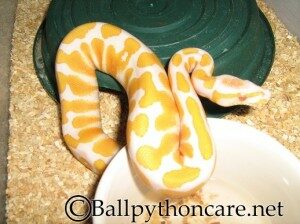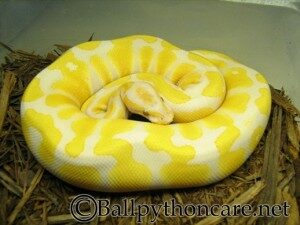
With the Ball python craze in full momentum it’s a great time to cover some tips and guidelines for inquiring about animals for sale.
I’ve bought hundreds of ball pythons over the years starting way back when I made my first ball python purchase as a young teenager.
I believe it was for my 13th birthday I headed down to the local pet store to see all the snakes they had for sale. I had my eye on a large ball python they had on display right there in the window for all to see.
I made the purchase with the help of my father asking few of any questions regarding the animal I was getting.
Well, that was a big mistake as this particular animal never ate a single meal for me over the course of 9-10 months that I owned it. I ended up giving it back to the pet store asking nothing in exchange just hoping they’d be able to get the animal feeding and it end up living a healthy life.
What have I learned since then? I’ve learned first and foremost that there are some questions that you most definitely have to ask when looking to buy a new snake. Let’s talk about some of these questions.
Captive Born and Bred vs. Wild Caught:
Is the animal captive born and bred or is the animal wild caught? This is the first question someone should always ask when looking to purchase a new animal.
The animal I just talked about buying when I was just 13th years old was mostly a wild caught animal straight out of Africa because in those days captive bred ball pythons were just not being produced.
With that, I had a bad experience with the species overall because wild caught animals are very challenging to successfully maintain in captivity.
Today wild caught ball pythons are still very popular in pet stores simply because they’re very cheap to purchase so some pets stores would rather make more money than sell quality animals. If the price on the snake seems a little too cheap chances are it’s a wild caught animal. I’d personally recommend against ever owning a wild caught ball python as they make terrible pets and they require tons of experience to keep them thriving.
If your local pet store doesn’t sell captive breed ball pythons then go elsewhere or look online.
Feeding Habits:

Is the reptile currently feeding and if so on what? It’ no secret that ball pythons tend to go on and off feed from time to time but this occurrence isn’t much of an issue with newly hatched captive breed animals so if you’re looking to buy a hatchling ball python or one that’s under 6 months old it should be actively feeding.
If the animal isn’t currently feeding I’d see that as a red flag as it may have other issues going on. If the animal is feeding you need to find out what it’s feeding on as ball pythons can be picky eaters and choose to eat one prey item and not another.
Knowing what the ball python is feeding on will enable you to offer it the exact item it’s been feeding on in the past.
Also, ask if it’s feeding on live prey items or frozen thawed items. If the animal has been feed nothing but live prey items it may be more challenging to convert the ball python over to taking frozen thawed prey items that are readily accessible at places like Pets Mart and local pet shops. If you have a source for live prey items like mice and rats then this isn’t an issue as just about any ball python that’s feeding on frozen thawed will take live prey items but it usually doesn’t work so easily the other way around.
Age Considerations:
What should I buy, an adult or hatchling? I personally don’t like buying adult animals because adults are much more likely to have underlying health issues than hatchling and require more ball python care.
Also, if you don’t know the full history of the adult ball pythons for sale you may unknowingly purchase an animal that has been struggling with an oncoming illness like respiratory infection.
This is a concern because respiratory infection seems to be a reoccurring issue with ball pythons that come down with the illness.
With that, your absolute best bet is to purchase a young hatchling from the current year to avoid any possible issues that can come from buying adults.
Reputable Breeders and Sellers:
When searching for a ball python, it is crucial to buy from reputable breeders or sellers. Responsible breeders prioritize the health and well-being of their animals, providing proper care, nutrition, and living conditions.
Reputable sellers will have a clean and well-maintained environment for their snakes, and they will readily provide information about the ball python’s history, feeding habits, and health records.
A reputable breeder or seller will be transparent and open to answering any questions you may have about the snake. They may even offer after-purchase support and guidance to ensure a smooth transition for your new pet.
Look for reviews and recommendations from other customers to gauge the breeder’s or seller’s reputation and commitment to their animals.
Health Assessment:
Before finalizing your purchase, thoroughly assess the health of the ball python. Look for signs of good health, such as clear and bright eyes, clean nostrils, and a well-maintained body condition.
The snake should appear alert and responsive. Beware of any signs of illness, such as wheezing, mucus discharge, or visible wounds.
Observe the snake’s behavior, noting its movements and activity levels. If possible, handle the snake gently to assess its temperament and docility.
A healthy ball python should not display aggressive or defensive behavior unless provoked.
If you are unsure about the snake’s health, consider seeking the opinion of a reptile veterinarian or an experienced reptile keeper before making your purchase. Make sure to check out more topics and head over to the Questions and Answers section on my blog. I’m here to help.
Quarantine and Health Check:
Discover the golden tip to ensure a smooth and healthy transition for your new ball python companion.
When buying a ball python for sale, it is essential to implement a quarantine period before introducing the new snake to your existing reptile collection. Quarantine serves as a precautionary measure to protect your current pets from potential diseases or parasites that the new ball python may carry.
During the quarantine period, keep the new ball python in a separate enclosure, ideally in a different room from your other reptiles. The quarantine period typically lasts for at least 30 to 60 days, allowing enough time to observe the new snake for any signs of illness or health issues.
Obtain a thorough health check from a qualified reptile veterinarian during the quarantine period. A veterinarian experienced in reptile care will perform a comprehensive examination, including fecal testing for parasites and a check-up for respiratory or skin issues.
While in quarantine, closely monitor the ball python’s behavior, appetite, and shedding process. Look for signs of stress, abnormal feces, or changes in appetite. Keep a record of your observations, as this information will be helpful for the veterinarian during the health check.
- Early detection of any health problems allows for prompt treatment and prevents the spread of potential illnesses to your other pets.
- Quarantine not only protects your existing reptiles but also safeguards the well-being of the new ball python. If any health issues arise during the quarantine period, you can address them before introducing the snake to its permanent enclosure.
- Additionally, this quarantine period gives you time to establish a strong bond with your new ball python. Spend time handling the snake gently and regularly to help it acclimate to your presence and build trust.
After the quarantine period is over and the ball python is given a clean bill of health by the veterinarian, you can confidently introduce it to your reptile collection.
Remember that each snake is an individual, and some may take longer to adjust to their new environment and socialize with their human caregivers.
Be patient, provide consistent care, and enjoy the rewarding experience of welcoming a new ball python into your home.
Conclusion:
In closing when buying ball pythons for sale you should be looking for a captive born and breed ball python that was born in the current year that you happen to be looking. Asking those key questions listed above and take your time picking out that perfect animal, these reptiles can and do live well over 30 years in captivity so taking the time necessary to choose the best animal for you is more than worth it. Have fun shopping!